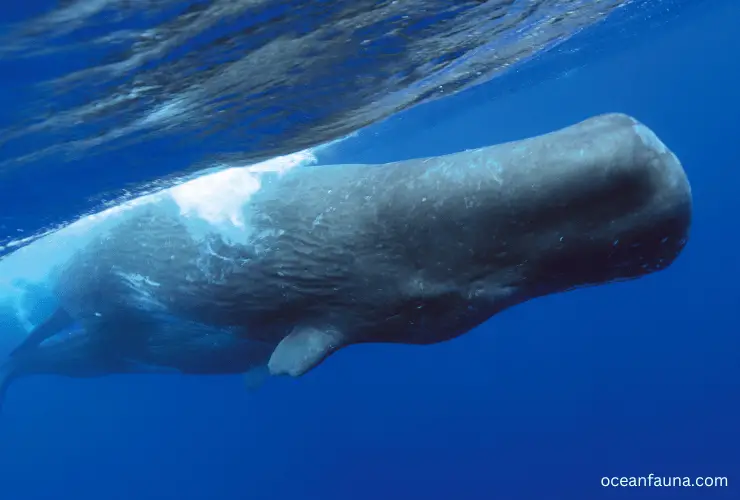The sleeping styles of all whales are not the same. For example, sperm whales are known for sleeping vertically in the water column. On the other side, humpback whales sleep horizontally.
However, this article is about sperm whales. Here I will tell how these whales sleep and why.
How Do Sperm Whales Sleep?

Sperm whales sleep uniquely vertically, floating motionless at the water’s surface or slightly below (around 10-15 meters). They remain entirely still during their sleep and do not breathe or move for periods of up to fifteen minutes. To maintain their balance, the whales will often curl their flukes or tails for increased stability while sleeping.
It is believed that sperm whales can shut off half of their brain while they sleep and use the other half to remain aware of predators as they drift. This style of unihemispheric slow-wave sleep is also seen in dolphins, where one eye remains open while the other is closed. This type of sleep allows them to rest while still maintaining some level of alertness and awareness.

Although it is unclear if sperm whales actually experience REM (rapid eye movement) sleep, researchers believe that the behavior is likely similar to other cetaceans. During REM sleep, cetaceans can be seen making small twitches, and head jerks, indicating a deep state of rest, much like humans do when dreaming.
Sperm whales also show signs of echolocation activity during this stage, which may also indicate some form of dreaming state.
Sperm whale mothers have been observed using a unique method called ‘porpoising’ where they rise out of the water and briefly swim towards shore before returning into deeper waters to continue sleeping with their calf by their side. This behavior indicates that female sperm whales can protect their calves even when asleep – an impressive feat.
Do Sperm Whales Sleep Vertically?
Yes, sperm whales sleep vertically in the water. They remain completely still and often use their tails to keep balance while sleeping on the surface. This behavior allows them to rest while remaining vigilant of predators in their environment.
Sperm whale mothers have also been observed using a unique porpoising technique to protect calves even when asleep.
Discovery of Vertical Sleeping of Sperm Whales
The discovery of sperm whales sleeping in a vertical position was first made back in 2008. After studying the behavior of these sea creatures, researchers published their findings in the journal Current Biology.
According to the findings, sperm whales would gather together into pods and drift just below the ocean surface for around 15 minutes at a time. During this period, they would remain completely still and not breathe or move.
This behavior was unlike anything that had been observed before and demonstrated that sperm whales could sleep while remaining in an upright, vertical position with their heads out of the water. This unique ability gives the whales a distinct advantage, allowing them to remain alert and aware of potential danger while also getting some much-needed rest.
The study revealed that when sperm whales sleep vertically, they actually engage in unihemispheric slow-wave sleep (USWS). This type of sleep is characterized by one half of the brain being shut down while the other remains active, allowing them to stay aware enough to keep breathing while also obtaining some restful sleep at the same time.
While USWS has been previously observed in certain species of birds and dolphins, its presence in sperm whales made this research particularly remarkable.
Furthermore, it is suspected that this behavior may help explain why these whales live such long lives; they can obtain quality sleep even when there is potential danger present, which allows them to be more energized during their daily activities and avoid exhaustion over time.
These combined factors have allowed scientists to gain valuable insight into how sperm whales function and survive despite their large size and limited mobility on land.
Why Do Sperm Whales Sleep Vertically?
According to research, sperm whales sleep vertically for oxygen supply, alertness, thermoregulation, and camouflage. Here are the details discussed below.

Oxygen Supply
Sperm whales sleep vertically to replenish their oxygen supply. They can take in more oxygen this way as the pressure of the water increases as they move further down, allowing them to absorb more oxygen from each breath. This also allows them to rest without having to swim actively and expend energy.
Alertness
Sperm whales also need to remain alert for potential threats, such as predators or environmental disturbances, so sleeping vertically helps them stay vigilant. This way, they can quickly surface if necessary, allowing them to react quickly and avoid any danger.
Thermoregulation
Sleeping vertically can be a way for sperm whales to regulate their body temperature. By orienting themselves parallel with the thermocline – the layer at which there is a rapid decrease in temperature – sperm whales can take advantage of cooler water during warmer months and warmer water during colder months.
This helps them maintain an optimal body temperature range, which is crucial for their health and well-being.
Camouflage
Another possible reason why sperm whales sleep vertically could be for camouflage purposes. By positioning themselves with the lighter blue of the sky above and the darker blue of the sea below, they are less visible from both above and below, making it harder for predators or humans to spot them from a distance.
How Do Sperm Whales Not Sink When They Sleep?
Sperm whales can remain stationary underwater when they sleep due to their ability to regulate their buoyancy. They have a large fatty organ, called the spermaceti organ, located in their forehead, which helps them achieve this. This organ is filled with a waxy substance that can be manipulated by the whale and can help give it extra buoyancy when needed.
Additionally, the whale’s air sacs, which are located around its lungs, act as bladders that can fill with air and help it maintain neutral buoyancy. The spine of the sperm whale also has considerable flexibility, allowing it to twist slightly as it swims and giving it better maneuverability in deep water.
Finally, its relatively large size helps it stay afloat while sleeping as well; generally speaking, larger creatures have more difficulty sinking than smaller ones due to having more mass to displace the surrounding water.
Do All Whales Sleep Vertically?
No, not all whales sleep vertically. Many species of whales prefer to sleep in a horizontal position close to the surface or at the surface. This resting position at the surface is referred to as “logging” due to its uncanny resemblance with a drifting log.

Species such as humpback whales are known for sleeping horizontally, while others, like sperm whales, usually sleep vertically. Some species may even alternate between both positions when they rest.
Additionally, researchers have noted that in some cases, whales may sink below the surface while sleeping and subsequently re-emerge sometime later. This pattern of sinking and resurfacing while sleeping is more commonly observed in certain species, such as beluga and narwhal whales.
How Long Does a Sperm Whale Sleep?
Sperm whales sleep for approximately 1.68 hours per day, which works out to be around 100.8 minutes or 7% of a day. It has been noted that they may be among the least sleep-dependent animals in the world, requiring far less rest than other mammals their size.
When asleep, a sperm whale usually rests for 10-15 minutes at a time and will often rest in the same position for multiple cycles of sleeping and waking.
During their resting periods, sperm whales can turn off half of their brain to reduce energy expenditure and conserve oxygen while still allowing them to remain aware of their surroundings and navigate safely. This brain activity pattern is known as unihemispheric slow-wave sleep and is unique to cetacean species like dolphins, beluga, orca, and sperm whales.
Conclusion
Hopefully, you understand the sleeping pattern of sperm whales and how and why they sleep vertically. This is another testament to the incredible intelligence and adaptability of these creatures. Also, it’s fantastic to see sperm whales sleeping straight up.


2 thoughts on “Why Do Sperm Whales Sleep Vertically? [Interesting!]”